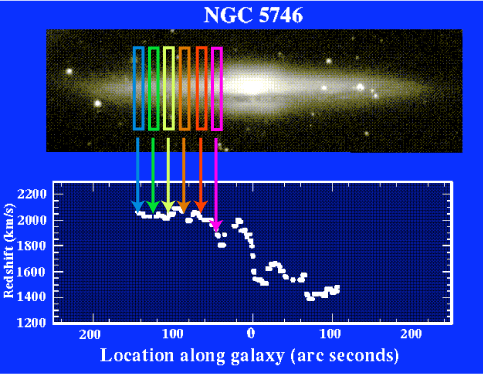Galaxies Still Misbehaving
This article is the first that deals with the idea of dark matter in the Cosmic Times. However, astronomers had discovered evidence of dark matter, or "unseen matter" in the 1930s. The location of dark matter observed in the 1930s was a bit different than that reported here (a cluster of galaxies versus a single galaxy), but the reasons for concluding that something was missing, something that we couldn't see, were similar for each discovery.
Observations Leading to the Idea of Dark Matter
The earlier discovery was published by Fritz Zwicky in 1933. Zwicky had observed the Coma cluster of galaxies, and seen that the speed of the galaxies in the cluster was too great for the amount of mass he could account for. By his calculation, the galaxies in the cluster should have been flung free of the cluster.
This story in the 1965 Cosmic Times reports that astronomers have found two galaxies that are rotating faster than they should be able to based on the mass calculated from the luminous matter (or matter that shines on its own, such as stars). In fact, the measurements indicated that if there was not more mass in these objects than meets-the-eye, the outer reaches of the galaxy should have been flung free of the galaxy long ago.
How the Presence of Dark Matter is Detected
In both observations of missing mass, astronomers observed that an object (galaxy or cluster of galaxies) was rotating too fast for the amount of mass in luminous matter. In the case of a galaxy cluster, the rotation can be measured approximately by measuring the redshifts galaxies in the cluster. For the case of a galaxy, astronomers can measure the rotation of a galaxy by measuring the redshift of different "slices" of the galaxy, as illustrated below.

This illustration shows how an astronomer might take redshift measurements of different slices of a galaxy to construct a rotation curve. (The center of the galaxy does not have a redshift (or rotational velocity) of zero because the galaxy has an intrinsic redshift due to the expansion of the Universe.)
Using redshifts for many slices of a galaxy, astronomers construct a "rotation curve" for the galaxy, plotting the distance from the center of the galaxy versus the rotation rate.
Now, if most of the mass is concentrated at the center of the galaxy, as is observed with the stars of a galaxy, we would expect that the stars at the outer edges of the galaxy would rotate slower and slower as you moved out. Instead, the observed rotation curves flatten out at the outer edges of the galaxy. This observation implies that the amount of matter in the galaxy does not taper out in the same manner that the luminous matter tapers out. In other words, there must be a lot of matter in the galaxy that is not seen as luminous matter.
It was not unexpected that some matter would be unseen in galaxies. Certainly, astronomers knew that stars died, and stopped shining, leaving behind non-luminous corpses. However, it was expected that luminous matter would be a tracer of all matter in a galaxy – in other words, the corpses of stars, which might account for much of the unseen matter, should lie in regions where stars have formed and are still shining. Instead, they found that there was much more mass than could be accounted for by the observed luminosity from the galaxy, and the distribution of that mass did not follow the distribution of light in the galaxy.
In 1965, dark matter is a growing mystery in astronomy. We will revisit dark matter in both the 1993 and 2006 editions of Cosmic Times. In fact, scientists continue to puzzle about the nature of dark matter, even today.
Other resources
The following webpages have more detailed information:
- RotCurve – a site with a Java applet that allows you to play with the different components of a galaxy to see that there is no way to fit the observed rotation curves with luminous matter as the tracer of matter in the galaxy.



